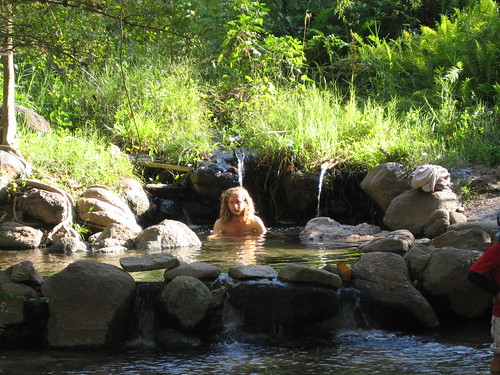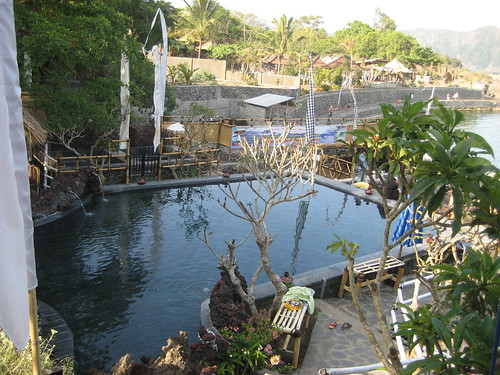Adding to the family of blogs is Hot Soaks of the Himalaya, a long (term?) journey up the valleys and across the vast plains of Himalaya. Just one entry so far, on Bhutan entitled 'Of Tsachu's', a tsachu being a hot spring.
Furthermore two visits have been paid to hot springs in Southern Thailand, postings to follow.
When one looks at the analysis of referrers one sometimes finds that Soaking in Southeast Asia pops up in the strangest places. A Google web search for 'Indonesia Banjar hot springs bikini photos' puts this site in the second place. But why on earth would someone being using those search terms?
News/Features
Asiaspa (Nov./Dec. 2009) goes green for it's latest issue. That's besides features on both Hanoi as well as Lao. Funny that focusing on the green thing but not mentioning green or 'natural' water. Though they do emphasize cleanliness of a spa, something you seldom see in the natural soaks of Southeast Asia.
In How to travel Green:
'Modest dress is important for many cultures and this is something many western travellers do not follow'.Sounds a lot like the blame the west attitude. Funny though when you leaf through the Mag you'll discover that advertisements for resorts in Southeast Asia focus more on non-modest (10) vs. modest (8; assuming bikini is modest). In pictures with articles the count is even 10 vs 4. So much for being modest, but possibly aforementioned being modest meant outside of the spa?
Furthermore a good article by Laura Miller on a visit to Beitou, Taiwan. Very forthright:
'There is something quite delicious about being naked outdoors. And although I'll admit to a slight exhibitionist streak, I'd challenge anyone not enjoy reclining nude in a marble pool of steamy healing water with trees and discrete screens ensuing total privacy from the opposite sex [so not exhibitionist?]. While skinny dipping is illicitly thrilling, hot spring nudity is actually recommended and deeply relaxing - especially under a blue sky or starry night'.That said, her name does sound western ....
From further away in Asia:
- The arrival of the Beaujolais Noveau 2009 is a reason for Japanese soakers to indulge:
'The Hakone Kowakien Yunessun spa resort celebrated the annual uncorking of the seasonal drop by having a sommelier pour a few bottles into an open-air hot spring bath as holiday-makers enjoyed soaking themselves. It was the fourth annual bath using the produce of the French winery Laboure Roi at the spa, which also offers baths with green tea, coffee and sake'.
What exactly are the benefits of soaking in wine tainted mineral water?
- Then there's a hot spring's music festival in Japan. The concerts actually take place in the bathhouse.
- And then a manga introduces the 'hot spring goddess' as reported by A NEET Life. Unfortunately Mr. NEET Life was expecting a naked Goddess because that's the way you soak in Japan.
'As you can see, right up my alley. My expectations of a series where the main character (who happens to be a cute girl with divine powers, for better or worse) never wears any clothes turned out to be a little high, unfortunately, but that's (also unfortunately) to be expected. But I'm totally down with the red letter philosophy above. Think about it. A nature god(dess) living at a hot spring. Where do clothes even fit into that? Oh, but of course, for the sake of modesty, we must go out of the way to clothe the naked. Even (or especially?) the divinely naked.
...
And worst of all, it offends my sense of spirituality. A God loses her majesty if she runs around naked? [quoting the manga] All I have to say about that is - she's a God, and this is a hot spring, so what's wrong with being naked!? Far as I'm concerned, a God gains majesty by running around naked. Partaking in nudity is spiritually fulfilling, not morally degenerate.'
- A newish site, Hot Springs in Beijing, highlighting mostly China's capitals ability to soak.
- China is also experiencing 'a wave of hot spring festivals' this autumn.
Thailand
- A year old write up in the Nation on Bo Klueng, Ratchaburi:
'Bo Klueng is a prime example of a poorly managed private tourist spot. The property owner has built a restaurant right next the hot spring to allow diners to watch those frolicking in the man-made pond into which the hot spring flows. Naturally, the focus is more on selling food and drink than maintaining the site, and the Bt5 admission fee is augmented by a Bt30 charge (Bt10 for children) for a dip in the pond. The water, which looks none too clean, is usually packed with children. And about 100 metres away, a sign is details the quality, which at pH8.02, seems more alkaline that it should be and not that hot at 56 degrees Celsius'.
I, for my part, admit that it's far from fantastic but did notice that they clean the pond and that it is still one of Thailand's best hot spring sites. Goes to show how good Thailand's soaks are. Possibly might visit there again next month.
- Another forum entry chips in on the above discussion so it seems:
'It certainly isn't the hot springs [of Pai, which attract tourists]. Until recently it was 300 baht for Farangs [foreigners] to go in and as a result the place was deserted. I think it is 100 baht now and still very quiet'.
 Red Rider in Pai.
Red Rider in Pai.- Tours to Binh Chau hot springs are back on offer. But only for the elderly ...
- Are there new hot spring pools in Kintamani, Bali? Bertrandom has the photo's (see below). But what is the place called?

Malaysia
- A previous unrecorded hot spring in Perak: Pengkalan Hulu. Motormouth from Ipoh has an extensive blog entry on this hot spring. A place to visit? Kavetha adds:
'The hot springs at air panas used to really nice until they decided to built that dirty canal and ugly chalets. There were 2 extremely hot pools which had railings around them, one big pool of warm water for swimming and a few more other little pools….. and for anyone who wanted a cold dip, they could just go to the river flowing nearby'.
Author's reply:'Chalets aside, they’re all orange-y now. But that canal looks too murky lah …. We did not touch the waters'.









No comments:
Post a Comment